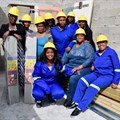Results from the 2019 Old Mutual Savings and Investment Monitor show that it is entirely possible that a new, parallel property finance market could be born out of the rapid rise of property stokvels. This potential for disruption is enormous considering that the size of the traditional stokvel market has grown to an estimated annual value of over R40bn.
“What started as an alternative savings mechanism outside of formal financial systems is today a significant force. And there’s no reason to believe that property finance is immune to millions of individuals pooling their resources for the benefit of stokvel members,” says Lynette Nicholson, head of research at Old Mutual.
The results of the recently released annual Old Mutual Savings & Investment Monitor tracks shifts in the financial attitudes and behaviour of South Africa’s working metropolitan population. The research into property stokvels was included for the first time in this year’s survey, and polled 15 founders and 105 members of these schemes.
Their responses reflect an increasing sense of self-empowerment as well as dissatisfaction with traditional lenders. This discontent ranges from barriers to finance and lengthy mortgage periods to punitive measures such as repossession for payment arrears.
Building generational wealth
Stokvels are not only familiar structures in black communities, but they also help to retain ownership and money within these communities. Applying this outlook to property ownership creates an avenue to building generational wealth and the dignity associated with owning a home.
“The true power of these schemes is reflected in the numbers - of both membership and their combined contributions,” Nicholson says. “The largest group that was surveyed, of more than 550 members, accumulates a staggering R24m a year from monthly contributions that range from R3,500 to R15,000.
“While that group may be an outlier in terms of size and volume of contributions, it’s not uncommon for members to contribute around R2,500 a month. A group with 100 members can therefore easily reach an annual investment of R3m and a group of 30 can accumulate R900,000 a year off relatively modest monthly contributions.”
Velani Ludidi 19 Mar 2019 Property stokvels
The more ambitious property stokvels are building investment property portfolios that are used to create generational wealth, while many assist members to buy or build a family home. Others are focused on helping members buy materials needed to complete a project.
Of the property stokvels that focus on home ownership and building homes for its members, the study reveals that members are predominantly female (89%), with 52% aged between 35 and 49. The younger members, below 35, make up 16% of membership and those over 50 constitute 31%.
One striking characteristic of these schemes is their unflinching focus on property finance, refraining from personal loans for other purposes.
They also have sophisticated governance in the form of scheme constitutions, using application forms as the contract between members and the scheme.
“It is clear from the responses to the survey that members see greater value and experience a greater sense of community from these schemes. The ability for lower income earners to realise a dream of owning their own home is also extremely powerful,” Nicholson says.

















































